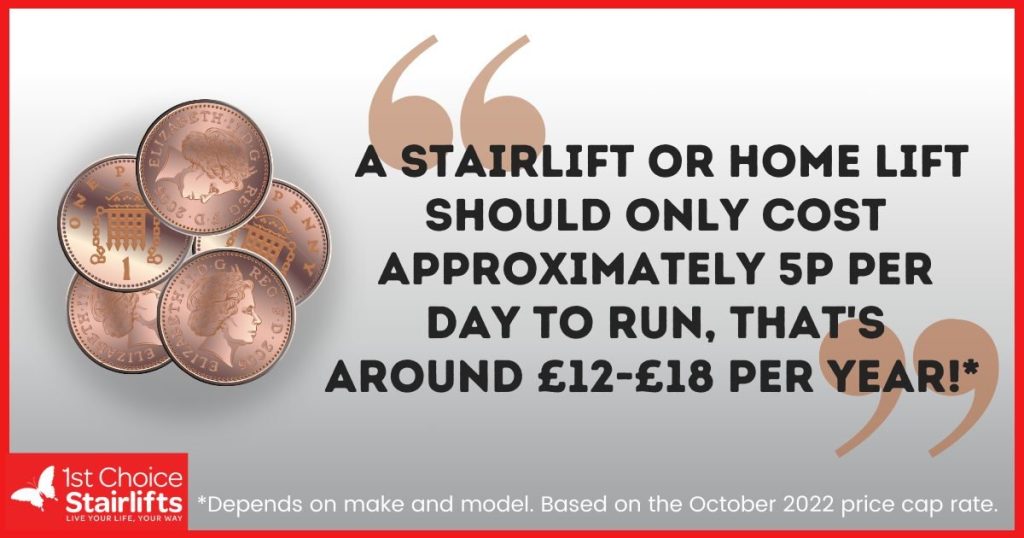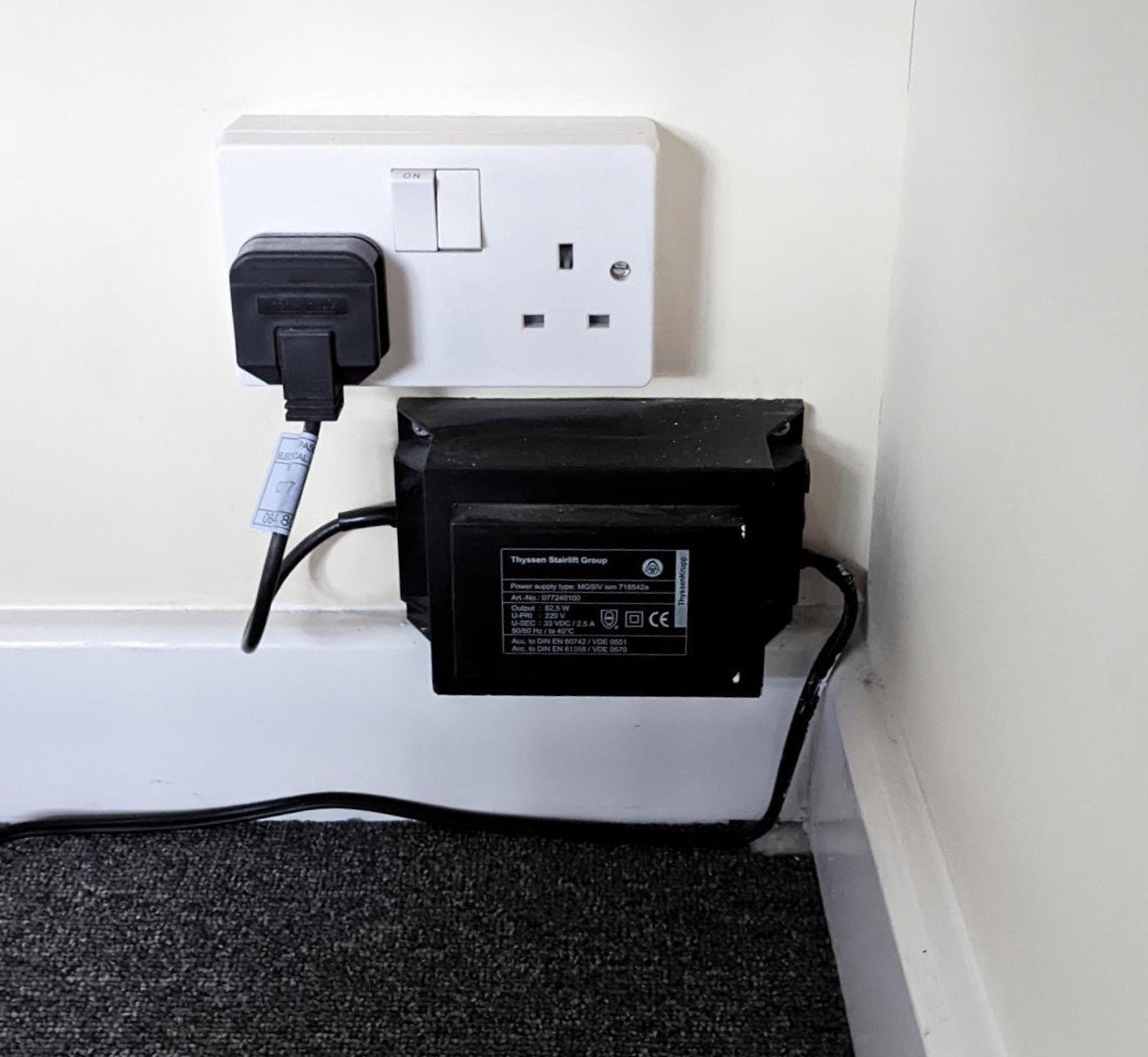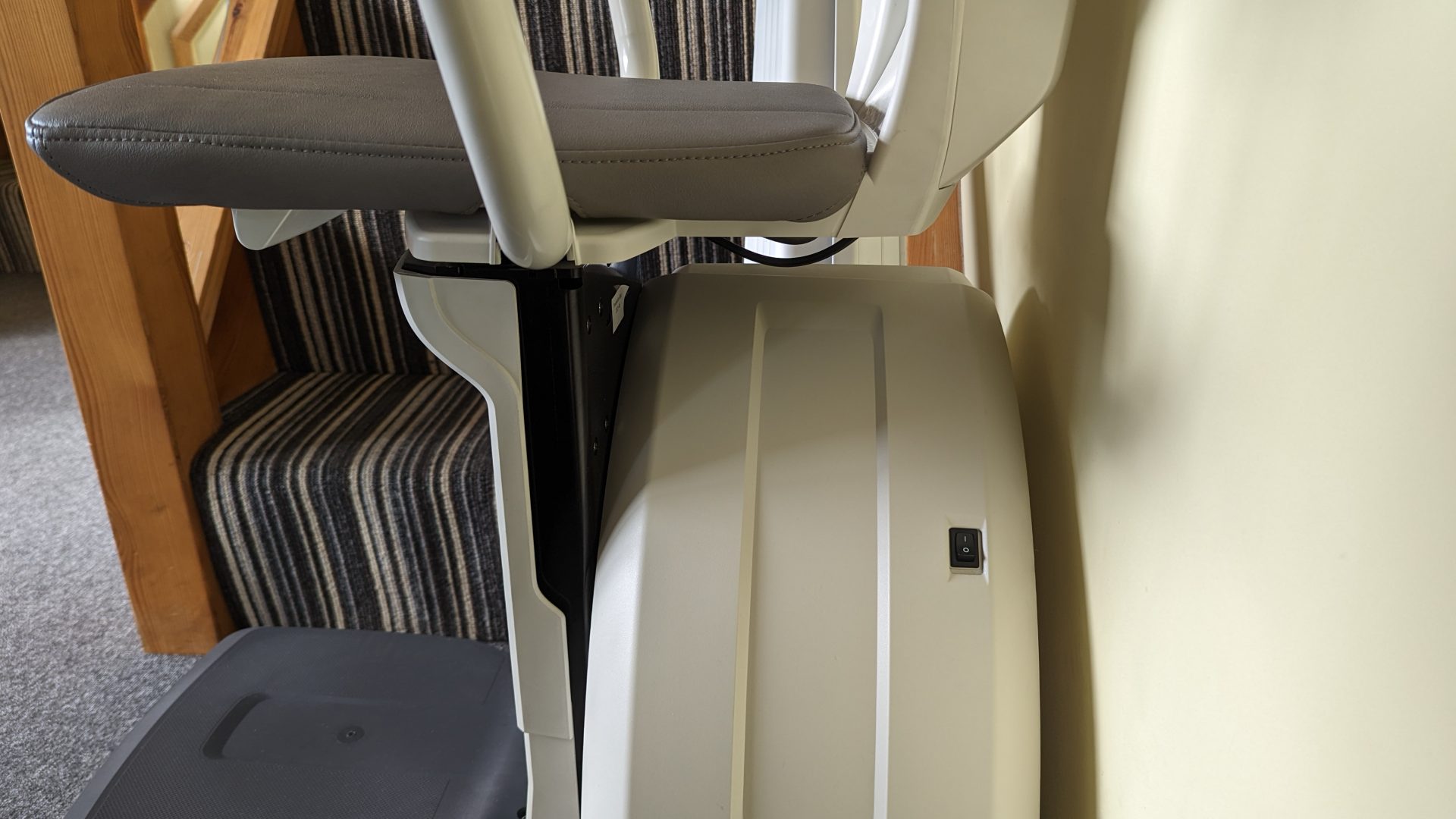
If you have a stairlift installed or are thinking about having one fitted, you may be concerned about how much it costs to run one, due to the recent rise in energy prices in the UK. There’s no need to be worried as stairlifts runs on minimal electricity and should only cost around 5p per day to run! So don’t be put off getting a lift or discouraged from using your existing lift – it is much more efficient than you think. We understand how concerning energy prices are at the moment, so we wanted to explain more about how much it costs to run your stairlift and discuss what you should do with your lift should you experience a power cut.

How is a stairlift powered?
Most stairlifts manufactured in the last 20 years are battery-operated. They have a battery charger unit with wiring into the house mains socket and the battery charging system on the stairlift rail (a copper charging strip). Inside the carriage motor there are two large batteries. When the lift is on charge, a low-voltage ‘trickle charge’ feeds the lift so the batteries are always topped up and ready for use. Stairlifts are powered by a 2-3Amp plug fuse, compared to your TV or electrical appliances that run off a 10-13Amp plug fuse.
How much does a stairlift cost to run?
Because this appliance runs on a low voltage, depending on the make and model (and based on the increased price cap rate: 1 October 2022), a stairlift will cost around £12-£18 to run per year, including when it’s left to charge – that’s less than 5p per day! Because the lift runs on the batteries during travel, the number of trips wont affect how much it costs to use.
Should I switch off their stairlift to save energy?
No, and here’s why. If the power is switched off at the mains for a long period of time, there will be no continuous charge into the batteries and they will run flat. You would then have to pay for a callout and a set of new batteries which would cost a few hundred pounds. Don’t be tempted to save a little money on electricity only to end up with a big repair bill!

Can I use my stairlift if there is a power cut or blackout?
Most lifts are battery-operated and therefore will work in a power cut or blackout, even if you are travelling on the lift at the time of the outage.
This is what would happen during a power cut and what you should do:
- You will hear a beeping. This is an alarm to alert the user that the lift is off charge. Turn off the lift using the switch located at the front or side of the carriage, whilst leaving it switched on at the mains. This will stop the beeping.
- The lift can still be used but trips should minimised.
- Uncharged, the batteries should provide 8 trips up and down the stairs.
- When the power comes back on, the lift will need to be turned back on or it will not charge. A stairlift battery that runs completely flat and then cannot be recharged will have to be replaced. They will come at an additional cost as batteries are not included in any warranty.
Does my lift need a check-up?
- When was your lift last serviced? All stairlifts should be serviced once a year. On this service we check the voltage in the batteries to make sure they are at their optimal running capacity and shouldn’t run flat.
- Are new batteries needed? The average lifespan of batteries is around 2-5 years, depending on usage. If a stairlift has been running slower than usual, that’s normally an indication that the batteries are running low and may run flat.
- Is the stairlift mains operated? Older stairlift models from 20+ years ago usually run on mains only. If you can’t see a copper strip charge point or a battery charger unit on the wall, the model is likely to be a mains-operated lift with no battery backup – consider replacing it.
In summary, a stairlift is energy-efficient because of the low-voltage battery-operated system it runs on which will enable it to be used in a power cut. Depending on the model it is likely to cost under £20 per year to run!
If you have a lift that needs servicing, new batteries or maybe even an upgrade, give us a call on 01249 814528 to talk to a member of our team! If you’re currently looking for a stairlift, check out our most popular straight and curved stairlifts.
Are you on the Priority Service Register (PSR)?
If you are worried about keeping supply going for emergency medical equipment then make sure you are registered on the Priority Service Register.
The PSR is a free support service to help people in vulnerable situations and is provided by your energy, network operators, and water supplier – just contact them and ask them about getting onto the register.
By being on the register, you will be told about planned interruptions to supply. Priority support can be given from emergency response organisations, you may provided with free bottled water or a generator for medical equipment you depend on.
For more information contact your supplier or take a look at these websites:
- www.ofgem.gov.uk/information-consumers/energy-advice-households/getting-extra-help-priority-services-register
- https://www.ofwat.gov.uk/households/customer-assistance/special-assistance/
- www.citizensadvice.org.uk/consumer/energy/energy-supply/get-help-paying-your-bills/getting-extra-support-from-your-energy-supplier/
More Energy Saving Tips
Lights
Switching off the lights when you leave a room can save you around £14 a year. However, don’t switch lights off at the expense of your safety. Keep your stairwell, kitchen and bathroom well lit when in use. Have you switched your lightbulbs to LEDs? LED lights need less energy to run and may be worth switching to when your current ones run their course.
Electric appliances
Do you switch off appliances when not in use rather than leaving them on standby (other than your stairlift)? When buying new appliances, check their energy rating to ensure they’re not eating your electricity up unnecessarily? Appliances that are not in good working order are less efficient and use more energy.

In the kitchen
If you have a dishwasher and/or a washing machine at home, be sure that they are full before running them. Using a lower temperature when washing your clothes will also save energy. There are a lot of detergent brands available that wash your clothes just as effectively at cooler temperatures. Defrost your freezer every 6 months to keep it running efficiently.
In the bathroom
Perhaps shower instead of taking a bath, short showers use a third of the amount of water needed for a bath! If you really love a bath, perhaps consider filling the tub slightly less. The average bath uses 80 litres of water!
Water
Are you on a water meter? Do you have any leaking taps? A dripping tap can waste the equivalent of half a bath a week. If you don’t have a dishwasher, fill a washing up bowl as opposed to cleaning your dishes under running water. When boiling a kettle, only boil as much water as needed or perhaps use a one cup kettle. This saves water and on the energy needed to heat the water.
General
Do you have draught excluders? Avoid heat loss by draft proofing doors, windows, and chimneys. Turn off radiators in rooms you don’t use, like a spare bedroom, and close the door.

Big changes to consider
Insulation is a great way to regulate the temperature of your home. Insulation will keep you warmer in the winter months and will help you save money on your energy bills. Consider topping up your loft insulation and having cavity walls filled. Window glazing is a great way to insulate your home. Many homes these days have double glazing, however their efficiency does decline over time.
Consider replacing your current your windows or upgrading them to triple glazing. With the rising costs of fuel, it may be worth considering switching to an electric vehicle (EV). Running an EV costs around £1.30 per 100 miles, compared to petrol cars which are around £11.05 according to EDF Energy. The cheaper running costs aren’t the only benefits of switching! Electric vehicles are also better for the environment as they don’t emit any exhaust fumes! We hope we have provided you with a few things to take away, or perhaps you were doing some of these already! Please remember, it is very important to have enough light and warmth in your home to stay safe and comfortable.









